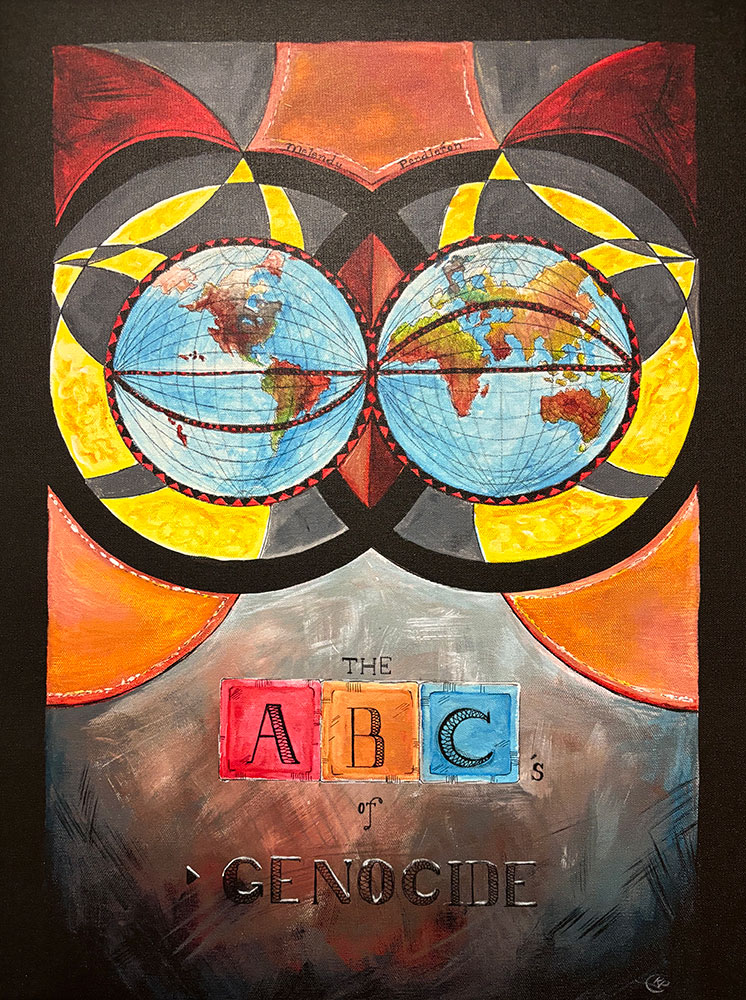ABCs of Genocide
 This installation grew out of a class project for Dr. Brenda Melendy’s Comparative Genocide history course in Spring 2019. Dr. Melendy and TAMUK alumnus Kevin Pendleton worked together to assign a genocide-related theme or event to each letter of the alphabet. Pendleton created the pen and ink drawings, while students in the Comparative Genocide course wrote the accompanying essays. The project came together when it was exhibited at TAMUK as part of Holocaust Days of Remembrance on May 2, 2019.
This installation grew out of a class project for Dr. Brenda Melendy’s Comparative Genocide history course in Spring 2019. Dr. Melendy and TAMUK alumnus Kevin Pendleton worked together to assign a genocide-related theme or event to each letter of the alphabet. Pendleton created the pen and ink drawings, while students in the Comparative Genocide course wrote the accompanying essays. The project came together when it was exhibited at TAMUK as part of Holocaust Days of Remembrance on May 2, 2019.
The title of this exhibit connotes a number of salient ideas. First, genocide is as common as ABC. The hard part of crafting an ABCs of genocide is not finding a genocidal theme for each letter, but instead, limiting the theme to only one per letter. The prevalence of genocide and genocidal acts throughout world history appear to indicate it is a basic feature of human societies.
Second, while genocide is not nor should be child’s play, learning about genocide should be fundamental to our educational institutions. Israel has introduced the Holocaust into their Kindergarten curriculum. Joseph Sebarenzi, a survivor of the Rwandan genocide, has pointed out that in order to prevent future genocides, conflict resolution is as essential a part of a K-12 curriculum as the multiplication table (or the ABCs).
Finally, memory and prevention go hand in hand, and both need to be intentional. By its legal definition, you can’t have genocide without intent. Acquiring knowledge about genocide, and remembering genocide, requires intent; it is neither an easy nor pleasant task. Preventing genocide also requires intent: the intentional practice of recognizing genocide when it is happening, and the intentional resolve to enforce the U.N. Convention on the Prevention and Punishment of Genocide. Only through a commitment to fundamental genocide education and to intentional remembrance and peace-keeping can the scourge of genocide be eradicated.
Dr. Brenda Melendy, Professor of History
About the Artist
Kevin Pendleton is an artist and teacher born in Laredo, TX and raised in Benavides, TX. He earned a Bachelor of Fine Arts in Art at Texas A&M University - Kingsville and is currently a graduate student in the Educational Leadership program at TAMUK and the Founding Art Innovations Facilitator at TriPoint Academy, San Antonio.
Prior to his role at Tri Point, Kevin spent seven years as a Teacher's Assistant to internationally acclaimed artists Fulden Sara and Charles Wissinger where he began developing his interdisciplinary approach to the arts and teaching. Kevin moved on from TAMUK to Benavides ISD where he taught in service of 1st-12th grade students, weaving student interests with the arts, research, and social/emotional development.
Kevin’s first approach to the arts as an educational language began with the development of the “ABCs of Genocide” collection. He collaborated with Dr. Brenda Melendy to complete a series of drawings and paintings pointing towards themes surrounding genocide. By using memorials, burial practices, and symbolism tied to each particular genocide, Kevin created a relevant link between the art and the content.
This installation serves as the first of many experiments with testing art as a language and sets the tone for his following creative years, study, and pedagogy to have art express those human abstractions which are compelling, impactful, and part of what it means to be human.
This art installation is viewable on the third floor of Rhode Hall and is sponsored by the Department of History, Political Science, and Philosophy.
Click on the links below for more information on each of the pieces.
